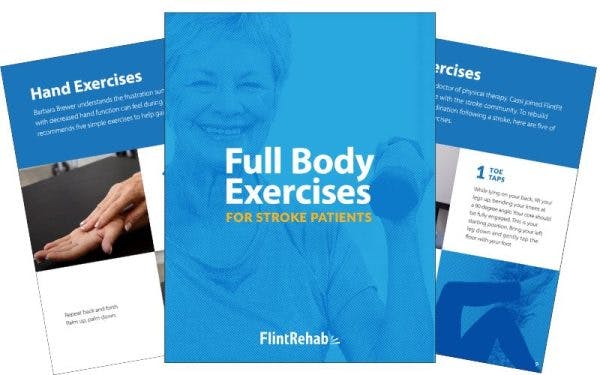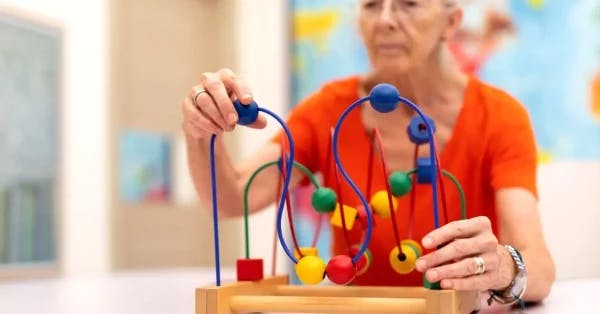A common question survivors ask after a stroke is: Am I just tired, or am I pushing too hard?
This question matters more than it may seem. On one hand, consistent rehabilitation is key to regaining mobility, cognitive skills, and independence. On the other, overexertion can stall progress or even put you at risk for setbacks. And, the line between healthy fatigue and harmful overdoing isn’t always clear which can leave you second-guessing your decisions.
Today, we’ll walk you through some of the differences between normal fatigue and pushing past safe limits after a stroke. We will cover some practical ways to check in with yourself, strategies to balance activity and rest, plus tips for managing energy so you can keep moving forward confidently.
So without further delay, let’s jump in!
Click below to jump directly to a section:
Why Stroke Recovery Feels So Draining
Why Striking a Balance Between Rest and Activity Is Important After Stroke
Common Triggers of Overexertion After Stroke
The Difference Between Healthy Fatigue and Overdoing It
Strategies to Monitor Whether You Are Tired or Overdoing It After Stroke
Using Energy Conservation Strategies
Why Stroke Recovery Feels So Draining
Fatigue isn’t just about feeling sleepy. It can show up as muscle heaviness, brain fog, lack of motivation, or an overall sense that everything requires more effort than before.
And that’s because it does!
A stroke disrupts communication between your brain and body, so everyday tasks like walking, talking, or concentrating genuinely demand more energy than before.
Plus your brain is simultaneously rewiring itself through neuroplasticity, which is mentally and physically exhausting. Add in the emotional weight of recovery, sleep disruptions from pain or medication, and the frustration of relearning basic skills, and it’s no wonder survivors feel drained.
However, understanding that this fatigue is a natural part of healing and not necessarily that you are doing anything wrong can help ease the worry many feel about needing additional rest.
Learn more about fatigue after stroke
Why Striking a Balance Between Rest and Activity Is Important After Stroke
Therapy is one of the most effective ways to rebuild strength and function after a stroke. But it’s also where the risk of overdoing it is highest.
Why Activity Is Important: Neuroplasticity requires challenge. When you repeat movements or tasks that feel hard, your brain forms new connections. Without pushing past your comfort zone, progress may stall.
Why Rest Is Equally Important: Those new pathways need recovery time. Too much strain without rest can lead to burnout, pain, or discouragement.
Striking the Balance Between Activity and Rest After Stroke
- Break therapy into shorter, frequent sessions instead of one long session.
- Focus on quality of movement, not just repetition.
- Communicate openly with your therapist about how you feel before, during, and after sessions.
A well-designed therapy program should push you just enough to spark improvement, but not so much that you can’t function afterward.
Common Triggers of Overexertion After Stroke
Certain situations are more likely to cause survivors to cross the line into overdoing it. Recognizing these in advance can help you prepare.
- Skipping breaks: Pushing through without rest increases fatigue.
- Trying to “catch up”: Some survivors feel pressure to make up for lost time, leading them to push too hard.
- Ignoring warning signs: Pain, dizziness, or brain fog often signal overexertion, but survivors sometimes push through out of determination.
- Daily activities stacked too closely: Multiple appointments, errands, and therapy on the same day can quickly drain energy.
By spacing out commitments and giving yourself grace, you lower the risk of setbacks. Remember, it is not only the physical demands of your day that may be exhausting. The mental load of juggling appointments, practicing therapy exercises, and planning meals and activities can be equally tiring, particularly for those experiencing cognitive changes after stroke.
The Difference Between Healthy Fatigue and Overdoing It After Stroke
Feeling tired after therapy, exercise, or a busy day is expected. It usually means you’ve worked your body and brain enough to promote change (i.e. recovery). But when does “good tired” cross into “too much”?
Think of healthy fatigue as the soreness you might feel after a workout at the gym: uncomfortable, but temporary, and often followed by gradual improvement.
Overexertion, however, leaves you feeling worse rather than stronger. It can slow recovery or lead to setbacks.
Here are some signs you can look for when determining whether you are experiencing healthy fatigue or overdoing it after your stroke. Keep in mind that these are general guidelines and you should always make sure to communicate openly with your therapist or care team if you have specific concerns.
Signs of Normal Fatigue After Stroke
- Muscles feel heavy but not painful.
- Energy improves with rest, food, or hydration.
- You can resume activities after a short break.
- Fatigue doesn’t prevent you from performing basic tasks the next day.
Signs You Might Be Overdoing It After Stroke
- Fatigue lingers long after rest.
- You feel dizzy, lightheaded, or confused.
- Pain, spasticity, or weakness increases noticeably.
- Sleep quality drops even further.
- You lose motivation for activities you normally enjoy.
7 Strategies to Monitor Whether You Are Tired or Overdoing It After Stroke
Your body often gives you subtle warnings before exhaustion sets in. Building a habit of checking in with yourself can help you stay within a safe and productive range during recovery. Here are some helpful ways to do that:
1. Use the “1-to-10” Energy Scale
After or during an activity, rate your energy level on a scale from 1 to 10. A score around 5 or 6 usually means you are pushing yourself in a healthy way. If you drop to a 2 or 3, it is probably time to rest.
2. Monitor Heart Rate and Breathing
Watch for signs like shortness of breath, a racing heart, or difficulty speaking in full sentences. These are clues that your body is working too hard. Breathing and heart rate should return to normal within a few minutes of rest.
3. Journal Your Patterns
Keep a simple log of how you feel before, during, and after activities. Track what you were doing, when fatigue set in, and how long it took to recover. Over time, this helps you spot trends and adjust your routine.
4. Notice Your Mood
Fatigue is not just physical. Sudden mood changes like frustration, irritability, or sadness can be signs that your body is overstretched. These emotional shifts can be early indicators of doing too much.
5. Check for Lingering Symptoms
It is normal to feel a little sore or tired after rehab. But if you are still feeling drained hours later or the next day, it may be a sign that you pushed too hard. Pay attention to pain, brain fog, or fatigue that does not go away with rest.
6. Do a Body Scan Check-In
Take a moment to mentally scan your body from head to toe. Do you notice tension, heaviness, or shakiness? Is your posture collapsing? These signals often appear before full exhaustion hits. A quick body check-in can help you decide whether to continue or pause.
7. Involve a Therapist or Care Partner
You do not have to manage this alone. A therapist or caregiver can offer valuable input. They might notice signs of fatigue you have overlooked or help adjust your routine based on how you are responding over time.
Using Energy Conservation Strategies
Employing energy conservation strategies may be especially beneficial for individuals having a hard time with managing post-stroke fatigue or over-exertion. While some stroke survivors may be able to modulate their energy levels independently, learning how and when to use energy conservation strategies can help others strike a balance between participating in a healthy amount of activity without overdoing it.
Occupational therapists may introduce energy conservation strategies to help individuals manage their daily activities without becoming exhausted. Common energy conservation strategies may include:
- Simplify tasks: break large activities into smaller components, such as cleaning just one small area of the home each day, rather than cleaning the whole house at once
- Rearrange your environment: place commonly used items in an easy to reach area
- Pace yourself: space out tasks and appointments, and take breaks when needed. Give yourself enough time for rest, including sufficient time for sleep
- Body mechanics and positioning: use good body mechanics when bending and lifting, and complete activities in a seated position as needed
- Delegate: prioritize essential activities. When appropriate, ask for help. Don’t hesitate to delegate challenging tasks, such as grocery shopping and meal preparation, to a family member or caregiver while you’re recovering
These strategies can help individuals reduce their energy expenditure throughout the day, which is particularly important for those struggling with overexertion. As you continue to recover, your energy levels may increase, and you may not need to rely on these strategies as much. Make sure you are continuing to push yourself, without becoming overly fatigued.
How Caregivers Can Help
For caregivers, distinguishing between tiredness and overdoing it can be tricky. This is especially true when loved ones may not always communicate their fatigue clearly.
Here are some suggestions for how caregivers can help keep survivors pushing toward recovery without overdoing it:
- Encourage scheduled rest, not just rest when exhaustion hits.
- Watch for mood changes, irritability, or physical signs of strain.
- Offer help with daily tasks to prevent stacking too much activity at once.
- Reinforce that resting is productive, not lazy.
When caregivers understand the signs, they can play a key role in preventing overexertion.
When to Seek Immediate Medical Advice
Sometimes fatigue signals more than just overdoing it. Contact your healthcare provider if you notice:
- Sudden, severe fatigue unrelated to activity.
- New or worsening weakness, numbness, or vision changes.
- Chest pain, shortness of breath, or irregular heartbeat.
- Persistent depression or loss of motivation.
These symptoms could indicate complications or other medical conditions that need attention.
Finding the Balance Between Tired and Overdoing It After Stroke
Stroke recovery is not about perfection, it’s about progress. There will be days when you feel strong and capable, and others when fatigue wins. Both are normal. What matters is learning to work with your body instead of against it.
By recognizing the difference between healthy tiredness and harmful overexertion, you give yourself the best chance at steady, sustainable progress. Each balanced step adds up, helping you recover both physically and mentally, while also regaining confidence and independence.
Key Takeaways
- Fatigue is common after stroke and doesn’t mean you’re failing.
- Healthy tiredness improves with rest, while overdoing it leaves lingering symptoms.
- Pay attention to signals like pain, mood changes, or lasting exhaustion.
- Balance therapy and daily activities with intentional rest periods.
- Caregivers can play a supportive role by watching for signs of strain.
- When in doubt, check with your healthcare provider to rule out complications.
Recovery is a long journey, but learning how to pace yourself ensures you can walk it with strength, safety, and hope.









